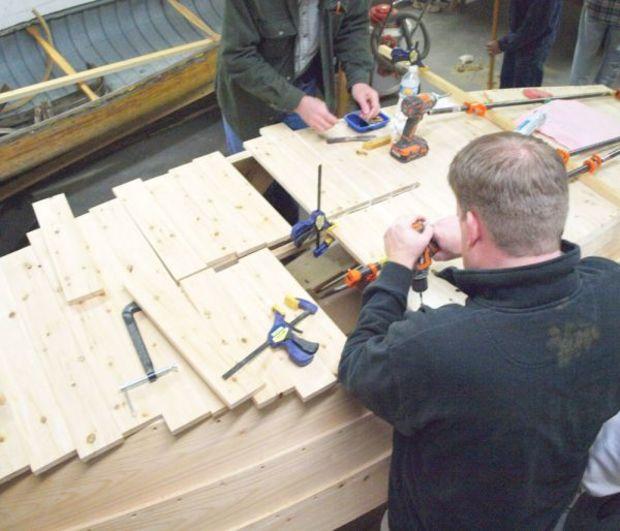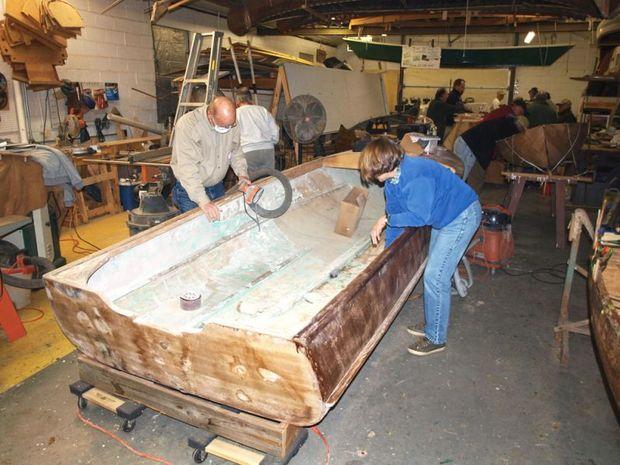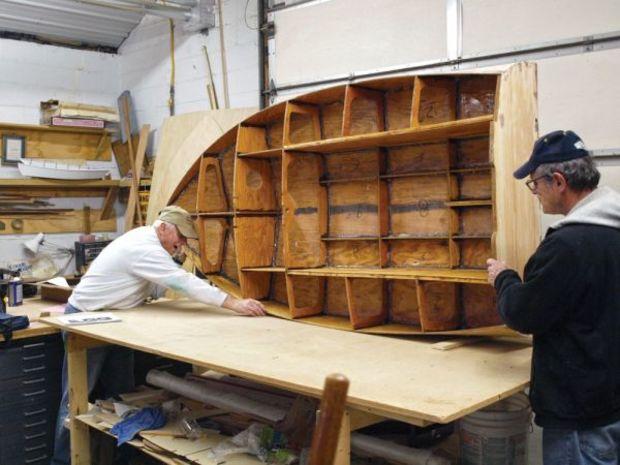
When we recreational boaters ply the waters of the Chesapeake in fiberglass hulls, most of us are at least dimly aware of the rich culture that preceded us rooted in local watermen making a living in craftsman-built, wooden boats. And when we think of where that watercraft heritage is being honored and preserved, we rightly think of the established museums and their professionally led boat shops in St. Michaels and Solomons.
But for almost 30 years there has been a small group of skilled amateurs building and restoring traditional and contemporary small wooden boats in the far northern reaches of the Bay.
The Chesapeake Wooden Boat Builders School debuted in 1989 as part of the non-credit curriculum of Harford Community College. It consisted of a dedicated group of skilled volunteers who enjoyed building wooden boats and were eager to share their knowledge. At various times the school has worked out of the basement of a cannery, an abandoned post office, and the lower level of the Havre de Grace Maritime Museum.
It currently resides on the campus of the Upper Bay Museum in North East, MD, for which it has restored several historic boats now on display. It is still affiliated with Harford Community College and is also part of the curriculum of Cecil College. Three non-professional but very accomplished wooden boat builders co-direct the school: Bud Gillis, Bob Silcox, and Don Kerr.
The school’s first project was a Chesapeake Bay sharpie built entirely from materials bought at local building supply stores. While space and budget have always dictated that their projects be small boats, the school has built a diverse fleet including a J. Francis Herreshoff Haven 12.5 sailboat, a number of crabbing skiffs with and without power, more than 50 restored wood and canvas canoes, as well as several restored, outboard-driven powerboats. In addition the school runs a week long Teen Boat Building class every summer where young builders complete a simple plywood rowing boat under the guidance of instructors from the school.

Two prop-powered boats are currently in the shop; one is a restoration, the other a build-from-scratch execution of a classic design. The restoration is a Whirlwind that was donated to the school. The 14-foot outboard-powered, cold-molded, plywood runabout was probably built in 1953 in Cockeysville, MD.
According to one of the students, John Barraclough, countless hours have already been spent carefully sanding away auto body filler putty that was completely covering the interior of the boat. When that’s done, even more care will be devoted to the plywood on the exterior. Previous sanding jobs have resulted in the mahogany veneer on the exterior being damaged in several areas. The students working on this boat intend to do some artful staining to mask some of the blemishes. In some areas new veneer will be applied. The donation included a vintage Johnson Super Sea Horse 33-hp outboard with electric start that will also be restored by volunteers.

The freshly built project is a Cocktail Class Racer based on plans from Chesapeake Light Craft. The boat is a 1939 design by Charles MacGregor, originally published in The Rudder Magazine. It was one of the earliest plans offered to homebuilders using plywood, then a novel material for amateurs.
In keeping with its cost-conscious tradition, this first Cocktail Class Racer project for the school was built from conventional marine plywood. Co-director Bob Silcox, who led the project with three other students, hopes they can step up to the much lighter okoume plywood for the next project in order to gain experience working with a new material as well as creating a faster, more competitive boat.
Timelines for school projects can extend into years. Classes meet only on Tuesday nights from 7 p.m. until 9:30 p.m. Some students and instructors gather occasionally on Saturdays to put in more time on work, but detailed projects can extend over several semesters. Volunteers also participate in several local community events where completed school boats are displayed. The Chesapeake Wooden Boat Builders School also displays regularly at the Mid-Atlantic Small Craft Festival at the Chesapeake Bay Maritime Museum in St. Michaels.
If you’d like to find out more about the school or find out how to enroll, find it on
Facebook or email
[email protected].
by Jerry McCann When we recreational boaters ply the waters of the Chesapeake in fiberglass hulls, most of us are at least dimly aware of the rich culture that preceded us rooted in local watermen making a living in craftsman-built, wooden boats. And when we think of where that watercraft heritage is being honored and preserved, we rightly think of the established museums and their professionally led boat shops in St. Michaels and Solomons.
But for almost 30 years there has been a small group of skilled amateurs building and restoring traditional and contemporary small wooden boats in the far northern reaches of the Bay.
The Chesapeake Wooden Boat Builders School debuted in 1989 as part of the non-credit curriculum of Harford Community College. It consisted of a dedicated group of skilled volunteers who enjoyed building wooden boats and were eager to share their knowledge. At various times the school has worked out of the basement of a cannery, an abandoned post office, and the lower level of the Havre de Grace Maritime Museum.
It currently resides on the campus of the Upper Bay Museum in North East, MD, for which it has restored several historic boats now on display. It is still affiliated with Harford Community College and is also part of the curriculum of Cecil College. Three non-professional but very accomplished wooden boat builders co-direct the school: Bud Gillis, Bob Silcox, and Don Kerr.
The school’s first project was a Chesapeake Bay sharpie built entirely from materials bought at local building supply stores. While space and budget have always dictated that their projects be small boats, the school has built a diverse fleet including a J. Francis Herreshoff Haven 12.5 sailboat, a number of crabbing skiffs with and without power, more than 50 restored wood and canvas canoes, as well as several restored, outboard-driven powerboats. In addition the school runs a week long Teen Boat Building class every summer where young builders complete a simple plywood rowing boat under the guidance of instructors from the school.
When we recreational boaters ply the waters of the Chesapeake in fiberglass hulls, most of us are at least dimly aware of the rich culture that preceded us rooted in local watermen making a living in craftsman-built, wooden boats. And when we think of where that watercraft heritage is being honored and preserved, we rightly think of the established museums and their professionally led boat shops in St. Michaels and Solomons.
But for almost 30 years there has been a small group of skilled amateurs building and restoring traditional and contemporary small wooden boats in the far northern reaches of the Bay.
The Chesapeake Wooden Boat Builders School debuted in 1989 as part of the non-credit curriculum of Harford Community College. It consisted of a dedicated group of skilled volunteers who enjoyed building wooden boats and were eager to share their knowledge. At various times the school has worked out of the basement of a cannery, an abandoned post office, and the lower level of the Havre de Grace Maritime Museum.
It currently resides on the campus of the Upper Bay Museum in North East, MD, for which it has restored several historic boats now on display. It is still affiliated with Harford Community College and is also part of the curriculum of Cecil College. Three non-professional but very accomplished wooden boat builders co-direct the school: Bud Gillis, Bob Silcox, and Don Kerr.
The school’s first project was a Chesapeake Bay sharpie built entirely from materials bought at local building supply stores. While space and budget have always dictated that their projects be small boats, the school has built a diverse fleet including a J. Francis Herreshoff Haven 12.5 sailboat, a number of crabbing skiffs with and without power, more than 50 restored wood and canvas canoes, as well as several restored, outboard-driven powerboats. In addition the school runs a week long Teen Boat Building class every summer where young builders complete a simple plywood rowing boat under the guidance of instructors from the school.
 Two prop-powered boats are currently in the shop; one is a restoration, the other a build-from-scratch execution of a classic design. The restoration is a Whirlwind that was donated to the school. The 14-foot outboard-powered, cold-molded, plywood runabout was probably built in 1953 in Cockeysville, MD.
According to one of the students, John Barraclough, countless hours have already been spent carefully sanding away auto body filler putty that was completely covering the interior of the boat. When that’s done, even more care will be devoted to the plywood on the exterior. Previous sanding jobs have resulted in the mahogany veneer on the exterior being damaged in several areas. The students working on this boat intend to do some artful staining to mask some of the blemishes. In some areas new veneer will be applied. The donation included a vintage Johnson Super Sea Horse 33-hp outboard with electric start that will also be restored by volunteers.
Two prop-powered boats are currently in the shop; one is a restoration, the other a build-from-scratch execution of a classic design. The restoration is a Whirlwind that was donated to the school. The 14-foot outboard-powered, cold-molded, plywood runabout was probably built in 1953 in Cockeysville, MD.
According to one of the students, John Barraclough, countless hours have already been spent carefully sanding away auto body filler putty that was completely covering the interior of the boat. When that’s done, even more care will be devoted to the plywood on the exterior. Previous sanding jobs have resulted in the mahogany veneer on the exterior being damaged in several areas. The students working on this boat intend to do some artful staining to mask some of the blemishes. In some areas new veneer will be applied. The donation included a vintage Johnson Super Sea Horse 33-hp outboard with electric start that will also be restored by volunteers.
 The freshly built project is a Cocktail Class Racer based on plans from Chesapeake Light Craft. The boat is a 1939 design by Charles MacGregor, originally published in The Rudder Magazine. It was one of the earliest plans offered to homebuilders using plywood, then a novel material for amateurs.
In keeping with its cost-conscious tradition, this first Cocktail Class Racer project for the school was built from conventional marine plywood. Co-director Bob Silcox, who led the project with three other students, hopes they can step up to the much lighter okoume plywood for the next project in order to gain experience working with a new material as well as creating a faster, more competitive boat.
Timelines for school projects can extend into years. Classes meet only on Tuesday nights from 7 p.m. until 9:30 p.m. Some students and instructors gather occasionally on Saturdays to put in more time on work, but detailed projects can extend over several semesters. Volunteers also participate in several local community events where completed school boats are displayed. The Chesapeake Wooden Boat Builders School also displays regularly at the Mid-Atlantic Small Craft Festival at the Chesapeake Bay Maritime Museum in St. Michaels.
If you’d like to find out more about the school or find out how to enroll, find it on Facebook or email [email protected].
by Jerry McCann
The freshly built project is a Cocktail Class Racer based on plans from Chesapeake Light Craft. The boat is a 1939 design by Charles MacGregor, originally published in The Rudder Magazine. It was one of the earliest plans offered to homebuilders using plywood, then a novel material for amateurs.
In keeping with its cost-conscious tradition, this first Cocktail Class Racer project for the school was built from conventional marine plywood. Co-director Bob Silcox, who led the project with three other students, hopes they can step up to the much lighter okoume plywood for the next project in order to gain experience working with a new material as well as creating a faster, more competitive boat.
Timelines for school projects can extend into years. Classes meet only on Tuesday nights from 7 p.m. until 9:30 p.m. Some students and instructors gather occasionally on Saturdays to put in more time on work, but detailed projects can extend over several semesters. Volunteers also participate in several local community events where completed school boats are displayed. The Chesapeake Wooden Boat Builders School also displays regularly at the Mid-Atlantic Small Craft Festival at the Chesapeake Bay Maritime Museum in St. Michaels.
If you’d like to find out more about the school or find out how to enroll, find it on Facebook or email [email protected].
by Jerry McCann